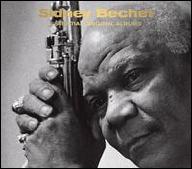Sidney Bechet studied clarinet in New Orleans with Lorenzo Tio, Big Eye Louis Nelson, and George Baquet and he developed so quickly that as a child he was playing with some of the top bands in the city. He even taught clarinet, and one of his students (Jimmie Noone) was actually two years older than him. In 1917, he traveled to Chicago, and in 1919 he joined Will Marion Cook's orchestra, touring Europe with Cook and receiving a remarkably perceptive review from Ernst Ansermet. While overseas he found a soprano sax in a store and from then on it was his main instrument. Back in the U.S., Bechet made his recording debut in 1923 with Clarence Williams and during the next two years he appeared on records backing blues singers, interacting with Louis Armstrong and playing some stunning solos. He was with Duke Ellington's early orchestra for a period and at one point hired a young Johnny Hodges for his own band. However, from 1925-1929 Bechet was overseas, traveling as far as Russia but getting in trouble (and spending jail time) in France before being deported.
Most of the 1930s were comparatively lean times for Bechet. He worked with Noble Sissle on and off and had a brilliant session with his New Orleans Feetwarmers in 1932 (featuring trumpeter Tommy Ladnier). But he also ran a tailor's shop which was more notable for its jam sessions than for any money it might make. However, in 1938 he had a hit recording of Summertime, Hugues Panassie featured Bechet on some records and soon he was signed to Bluebird where he recorded quite a few classics during the next three years. Bechet worked regularly in New York, appeared on some of Eddie Condon's Town Hall concerts, and in 1945 he tried unsuccessfully to have a band with the veteran trumpeter Bunk Johnson (whose constant drinking killed the project). Jobs began to dry up about this time, and Bechet opened up what he hoped would be a music school. He only had one main pupil, but Bob Wilber became his protégé.
Sidney Bechet's fortunes changed drastically in 1949. He was invited to the Salle Pleyel Jazz Festival in Paris, caused a sensation, and decided to move permanently overseas. Within a couple years he was a major celebrity and a national hero in France, even though the general public in the U.S. never did know who he was. Bechet's last decade was filled with exciting concerts, many recordings, and infrequent visits back to the U.S. before his death from cancer. His colorful (if sometimes fanciful) memoirs -Treat It Gentle and John Chilton's magnificent Bechet biography -The Wizard of Jazz (which traces his life nearly week-by-week) are both highly recommended. Many of Sidney Bechet's recordings are currently available on CD. ~ Scott Yanow, Rovi















